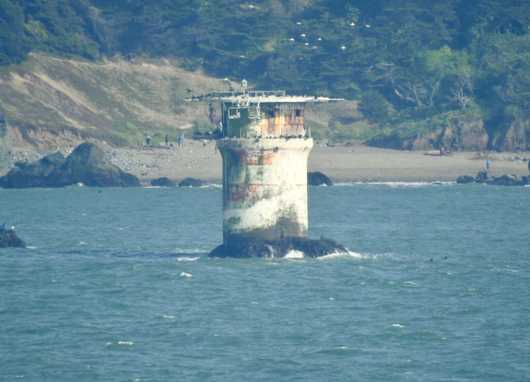Mile Rocks

Following the wreck of the SS City of Rio de Janeiro in heavy fog in February 1901, which claimed the lives of 128 of the 209 on board, it became clear that the navigational aids on the approach to San Francisco were inadequate. In response to the tragedy, Congress approved funds for a lighthouse to be built on the Mile Rocks, and construction began in 1904.
The construction work was incredibly challenging. Waves constantly lashed the construction site, and before anything could even be built, the rock had to be blasted flat.
Completed in 1906, the lighthouse was once an impressive example of a caisson tower. The lower portion of the tower, the caisson itself, is a concrete construction, lined with steel plates - it is almost entirely solid, with only a few hollow spaces for storage, water tanks and cisterns. Originally this 10.6-meter-high section was originally painted black. Above this were further tiers resembling those of a wedding cake, each narrower than the last; the first is the oval-shaped oil room, which survives today as the base of the helipad, atop which the cylindrical tower was built. These sections were painted all white. The top of the tower was crowned by a lantern room, painted black, which housed a compact Third Order rotating Fresnel Lens, built by L. Sautter & Co. of Paris.
In 1965 the lighthouse was decommissioned and replaced by a gong buoy, allowing the station to undergo upgrade work that would enable automatic operation of the light. Despite opposition and attempts to save parts of the tower, including plans for some of it to be relocated to the mainland, the cost of this proved prohibitive, resulting in the complete destruction of the upper floors and lantern room. The Fresnel lens was removed and transferred to Old Point Loma Lighthouse near San Diego, and a helipad was built to enable the new automatic light to be accessed.
The truncated remains of the lighthouse can be viewed from several viewpoints west of the Golden Gate, including Point Bonita and the Marin Headlands on the northern side, and Mile Rock Beach to the south. The caisson is painted white with orange stripes. Had the lighthouse survived in its original form, it would have undoubtedly become an instantly recognisable landmark of the San Francisco area.
